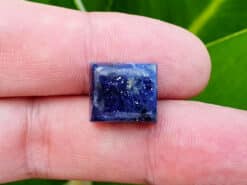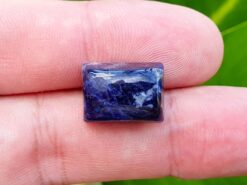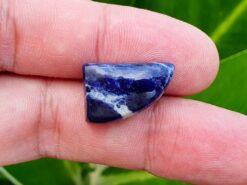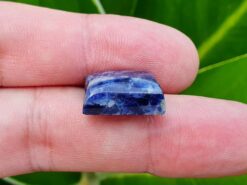Sodalite

Sodalite crystal stone meaning and properties.
Buy natural sodalite in our shop
Sodalite is a rich royal blue tectosilicate mineral widely used as an ornamental gemstone. Although massive stones samples are opaque, crystals are usually transparent to translucent. It is a member of the sodalite group with hauyne, nosean, lazurite and tugtupite.
First discovered by Europeans in 1811 in the Ilimaussaq intrusive complex in Greenland, THe stone did not become important as an ornamental stone until 1891 when vast deposits of fine material were discovered in Ontario, Canada.
Structure
The stone is a cubic mineral which consists of an aluminosilicate cage network with Na+ cations in the interframework. This framework forms a cage structure, similar to zeolites. Each unit cell contains two cage structures.
Natural stone holds primarily chloride anions in the cages, but they can be substituted by other anions such as sulfate, sulfide, hydroxide, trisulfur with other minerals in the sodalite group representing end member compositions.
Sodalite properties
A light, relatively hard yet fragile mineral, The gemstone is named after its sodium content; in mineralogy it may be classed as a feldspathoid. Well known for its blue stones color, it may also be grey, yellow, green, or pink and is often mottled with white veins or patches.
The more uniformly blue material is used in jewellery, where it is fashioned into cabochons and beads. Lesser material is more often seen as facing or inlay in various applications.
Sodalite vs lapis lazuli
Although somewhat similar to lazurite and lapis lazuli, it rarely contains pyrite, a common inclusion in lapis, and its blue stone color is more like traditional royal blue rather than ultramarine. It is further distinguished from similar minerals by its white, rather than blue, streak. Sodalite’s six directions of poor cleavage may be seen as incipient cracks running through the stone.
The stone is rarely seen in crystal form and can sometimes be found intertwined with white calcite.
It is sometimes referred to as poor man’s lapis due to its similar color and the fact that it is much less expensive. Most stones will fluoresce orange under ultraviolet light, and hackmanite exhibits tenebrescence.
Sodalite meaning and healing properties benefits
The following section is pseudo scientific and based on cultural beliefs.
The crystal encourages rational thought, objectivity, truth and intuition, along with verbalization of feelings. It brings emotional balance and calms panic attacks. It enhances self-esteem, self-acceptance and self-trust. The rock balances the metabolism, boosts the immune system and overcomes calcium deficiencies.
The stone has a strong vibration that is particularly helpful to aid the development of psychic abilities and with developing intuition.
Sodalite and Throat Chakra
Like many blue crystals this is an excellent stone for communication, with an action that is strong within the throat chakras.
FAQ
Where should I put sodalite stone in my home?
Hold a gemstone near the brow and throat to experience benefits. Use it in a body grid while lying on your back. Place a rock on the throat and brow.
What chakra is sodalite?
Because of its connection to the third eye chakra, the crystal can strengthen your intuitive sense and your inner knowing. By clearing and activating this energy center, you can more easily access your inner wisdom with the help of your rock.
Does all sodalite glow?
Most stones will fluoresce orange under ultraviolet light, and hackmanite exhibits tenebrescence.
How can you tell if sodalite is real?
If it has a lot of grey, it’s mostly like the raw stone. If you know how to do a streak test, the rock will ave a white streak whereas lapis will have a light blue streak. Cheap price is usually an indicator of a fake.
What does a sodalite crystal look like?
the rock is usually blue to blue-violet in color and found with nepheline and other feldspathoid minerals. It is usually translucent, with a vitreous luster, and has a Mohs hardness of 5.5 to 6. The crystal often has white veining, and it can be confused with lapis lazuli.
How much is a sodalite rock worth?
The rock is worth very little as it is abundant in a few locations in the world. The value of the stone will be under 10$ per carat due to its abundance and availability.
Natural sodalite for sale in our gem shop
We make custom made sodalite jewelry as engagement rings, necklaces, stud earrings, bracelets, pendants… Please contact us for a quote.
















